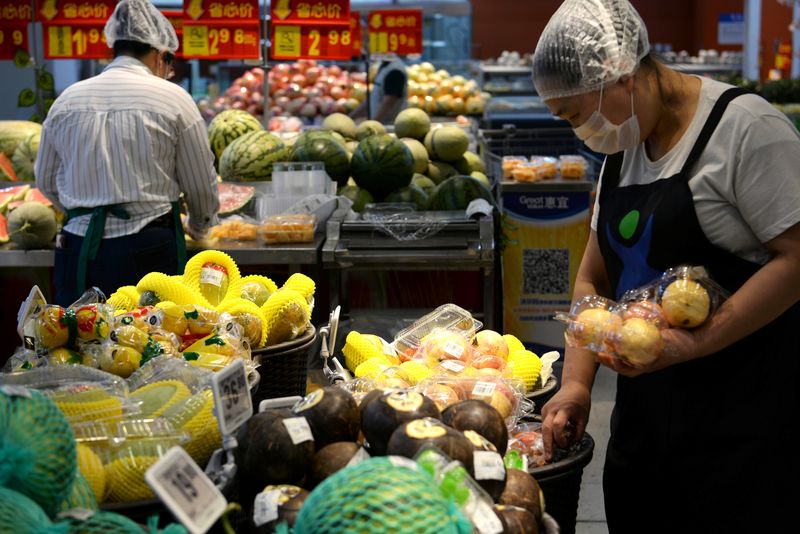China swings into deflation as recovery falters
2023.08.09 00:46

© Reuters. FILE PHOTO: Staff sort fruits at a Walmart in Beijing, China, September 23, 2019. Picture taken September 23, 2019. REUTERS/Tingshu Wang/File Photo
BEIJING (Reuters) -China’s consumer prices fell into deflation in July, while factory gate prices extended their declines, as the world’s second-largest economy struggled to revive demand and pressure mounted for authorities to release more direct stimulus.
The consumer price index (CPI) for the month dropped 0.3% year-on-year, the National Bureau of Statistics (NBS) said on Wednesday, a slightly slower fall than the median estimate for a 0.4% decrease in a Reuters poll. It was the first year-on-year decline since February 2021. CPI was unchanged in June.
The producer price index (PPI) fell for a 10th consecutive month, down 4.4% from a year earlier after a 5.4% drop the previous month. That compared with a forecast for a 4.1% fall.
China’s economic recovery slowed after a brisk start in the first quarter, as demand at home and abroad weakened. Authorities have rolled out a flurry of policy measures to support the economy, with more steps expected.
“Both CPI and PPI in year-on-year terms fell into negative territory and confirmed economic deflation,” said Xing Zhaopeng, senior China strategist at ANZ.
Xing expected the CPI to hover around 0 in the second half of the year, saying “it would be hard to manoeuvre monetary policy. The Politburo meeting called for a stable yuan exchange rate, which would conflict with monetary easing.”
Asian shares were on the defensive on Wednesday as the Chinese price data confirmed its economic recovery economy was losing steam.
China’s stock- bluechip CSI300 Index and the both declined after the figures.
“Markets needs to see more actionable support measures from the Chinese authorities to stay upbeat,” said Frances Cheung, rates strategist at OCBC Bank in Singapore.
“While there is room for some mild monetary policy easing, the onus is on the fiscal side. Otherwise, economic data showing some growth improvement is required, which is not coming through yet.”
JAPAN-STYLE DEFLATION?
The figures come amid mounting fears China is entering an era of much slower economic growth akin to the period of Japan’s “lost decades” since the 1990s, which saw consumer prices and wages stagnate for a generation.
China’s anaemic prices contrast sharply with the crippling inflation most other major economies have seen, which forced central banks elsewhere to rapidly raise interest rates.
However, there are also signs global inflation may be peaking and in some cases reversing with prices in Brazil sharply slowing, raising the sudden prospects of an interest rate cut in the world’s 10th largest economy.
Chinese authorities have downplayed concerns about deflation. Liu Guoqiang, deputy governor of the central bank, last month said there would be no deflationary risks in China in the second half of the year, but noted the economy needs time to return to normal after the pandemic.
The NBS said separate statement CPI was expected to rebound as the economy recovers and the relationship between supply and demand improves.
The government has set a consumer inflation target of around 3% this year, which be up from 2% recorded in 2022.
Despite recent policy stimulus, consumers and manufacturers remained cautious amid the still-weak housing market and high youth unemployment, and a diminishing appetite among foreign firms to invest in China.
Investors have been anxiously waiting for policymakers to inject stimulus measures after the powerful Politburo meeting last month, with the stock market mostly underwhelmed by the lack of concrete actions.








